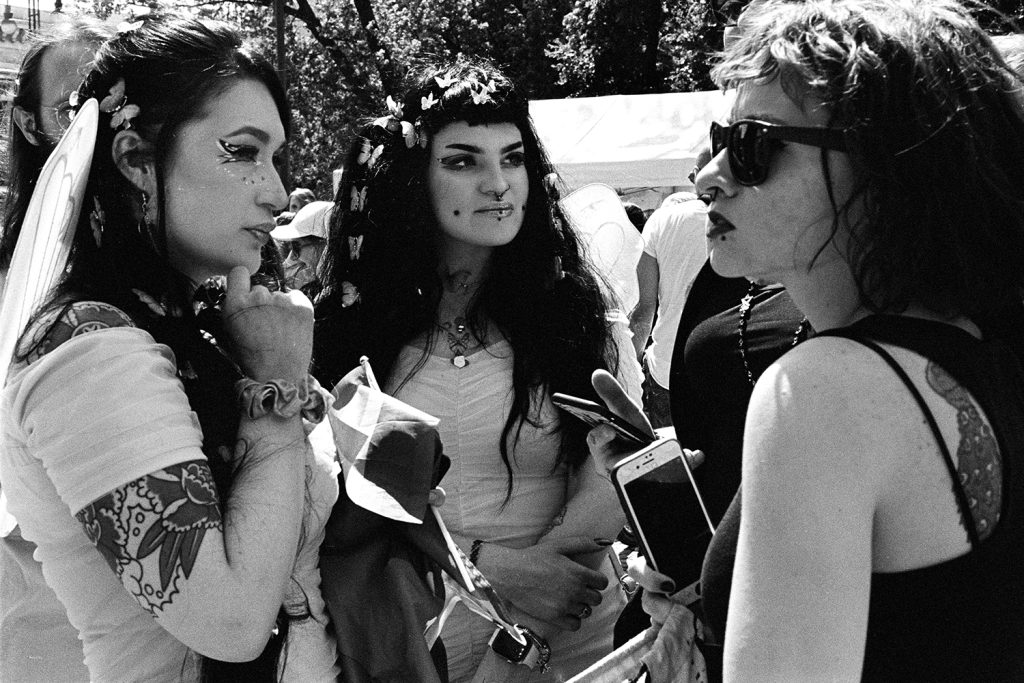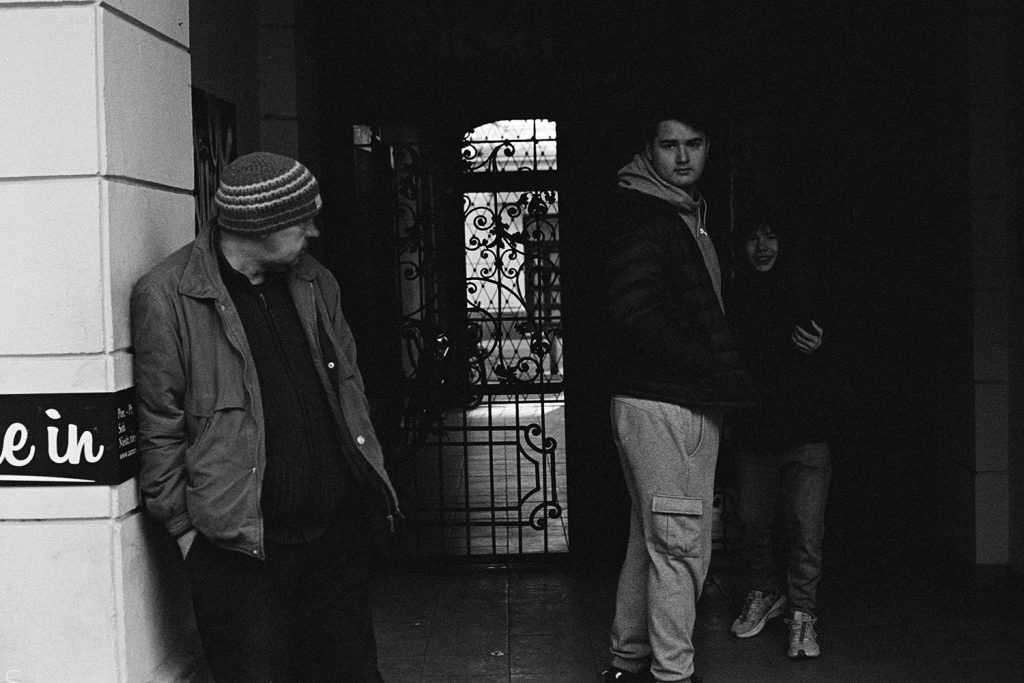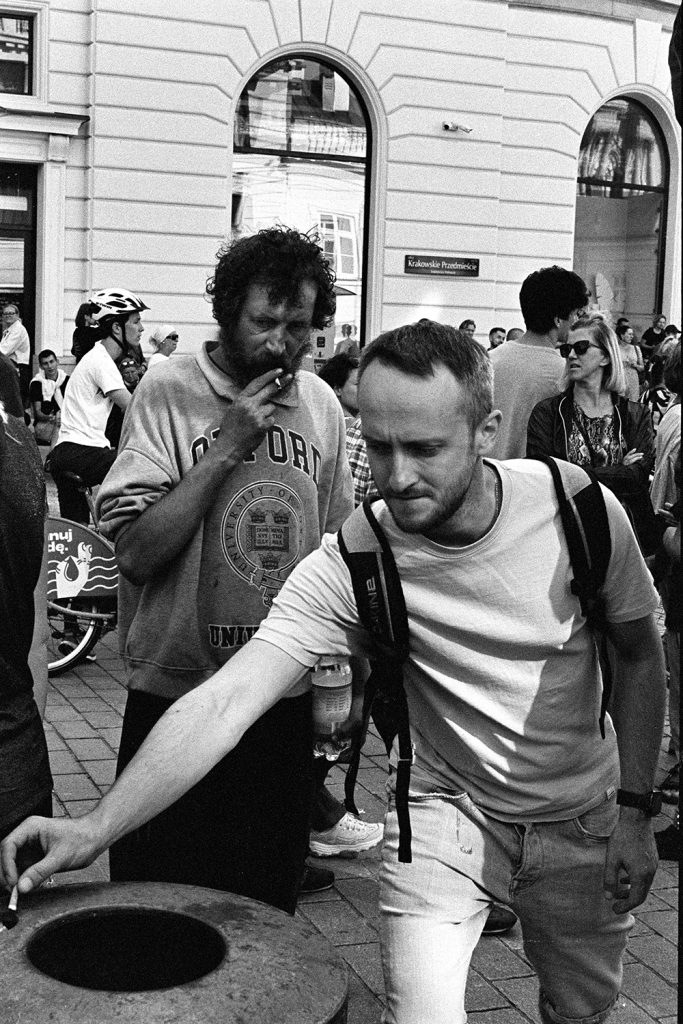
In answering the question of who makes street photography, let’s consider the characters and personalities of those who are drawn to street photography. Who pick up their cameras curious about what life will offer up for the lens out on the street? While reflecting on this, I discovered “Escaping Into Life – a psycho study of the contemporary street photographer“, a book by Australian writer Andrew Stark. While over-long and needlessly florid, the text reinforced many of my thoughts on the street photographer’s psyche.
A Spectrum
We all sit on a spectrum stretching between introverted personalities and extroverts. Some of us fall closer to either extreme, while others are a patchwork of the two. Who, then, has the right character for street photography? Well, as it turns out, both introverts and extroverts make for strong, creative street photographers, though each character may adopt a different approach.
Introvert Street Photographers
Introverts are observant by nature with sharp awareness of body language and expression. In groups, they are most often found on the periphery surveying rather than participating. In public, introverts are inveterate people-watchers; perceptive and empathetic.
Street photography is often a solitary creative pursuit, surrounded by people yet alone. Preferring to avoid open confrontation, acting as an unseen, inconspicuous hunter suits an introvert well. The introverted street photographer prefers not to affect a scene, instead soaking in the street and with anticipation, capturing it as it appears without active participation.
Extrovert Street Photographers
In contrast, extroverts are socially confident and enlivened by people around them, so as street photographers they have less need to feel hidden. With fewer reservations for injecting themselves into a scene they are more inclined to strike up a conversation with their subjects, whether before or after making the photograph.
Extrovert street photographers are often kinetic, constantly on the move, active, and with endless energy. Using their assertive nature as an advantage they may be more naturally courageous, and some may even employ a confrontational style to elicit a reaction from their subject.

The Myers-Briggs Personality Type Indicator
So how might we determine where on the spectrum we find ourselves? One way is the The Myers-Briggs Personality Type Indicator. This is a test designed to identify preferences and strengths thus indicating a personality type. Based on answers given to a number of questions, respondents are identified as 1 of 16 personality types. Answers may change over time and no personality is better than another. The test allows one to better understand their strengths and weaknesses and preferences.
Before delving further a short caveat: The MBTI is an indicator towards a personality type, it is not an absolute. The final result indicates preferences towards certain behaviours, not behaviours in and of themselves.
The questionnaire is set across 4 different scales. For more on these, there is an abundance of information out there, but I will briefly describe each.
(E) Extroversion – Introversion (I)
This scale is described comprehensively above. Although we all exhibit some extroversion and some introversion, most people will favour one over the other.
(S) Sensing – Intuition (N)
This indicates how people receive information about their surroundings. As above, people favour one over the other. Those who lean towards sensing focus on facts, details, and external stimuli, whereas those who tend towards intuition think more of possibilities and imagine what may be.
(T) Thinking – Feeling (F)
This scale points to how decisions are made. Thinkers may act logically and seem impersonal, whereas those who tend towards feeling are more likely to be swayed by emotion.
(J) Judging – Perceiving (P)
Finally, this scale shows how people interact with the world. Those who tend towards judging prefer firm decision-making, whereas those who lean towards perceiving may be more flexible in their choices.
The eventual result of a test will represent one of 16 possible combinations of these scales, and most often further details provided will indicate how strong the preference was on each of the 4 scales.
Once a result is known, there are a myriad of websites where you can read more about what this personality type says about specific strengths, weaknesses, and preferences.

Street photography personality types
In the aforementioned book, Escaping Into Life, Andrew Stark polled a number of street photographers from around the world. While the sample size was small, the results were nevertheless striking. By a vast margin, most street photographers polled shared the Introvert and iNtuition preferences, with the result INFJ, indicating preferences for introversion, intuition, feeling, and judging, sharing the top spot. By what now feels like no coincidence at all, this was the result I received when I took the test in September of 2021.
A brief interlude
For much of my adult life, I have considered myself an extrovert. I enjoy telling stories. I would perform onstage, and I would DJ at parties. And yet, when not onstage, I often felt discomfort, crippling shyness, and fear of embarrassment. In my 20s, I yearned to be part of a team and creative collaboration was key. In my 30s, I found myself less tolerant of compromise and more controlling of my creativity – something that, at the very least, contributed to the collapse of two bands. Several years of therapy have helped me understand why, now in my early 40s, I have become more insular, enjoying my own company, and through plans, schemes, and ideas, live life more frequently in my own head. It turns out I’m an introvert with behaviours of high-functioning anxiety. Well, now.
Understanding myself as an introvert has changed my life. I appreciate why I often prefer my own company to that of others. I no longer chastise myself for wanting to work on my own. And I don’t feel I have failed myself and others if an opportunity to collaborate falls through. What a difference this has made.

So Who Makes Street Photography
As shown above, both introverts and extroverts can make excellent street photographers but may have different approaches to their work. It is said that Michael Stipe of R.E.M. – a famous introvert, and talented photographer himself – formed the band partially to overcome his innate shyness. Many introverted street photographers take up the camera to use their personality to their advantage, but it is not such a leap to imagine some may do so to push themselves out of their shell.
Extroverts on the other hand are quite happy to be out on the street peacocking with the camera in their hand and capitalising on all that inherent self-confidence. Though again, it isn’t too difficult to imagine the extrovert who takes up street photography to kick against their tendencies and instead disappear among the crowds.
Did you take the test? Did it help you better understand your preferences? Let me know in the comments.
This is the 4th part of the 5 Ws of Street Photography where I write about the What, the Why, the Where, the Who, and the When of street photography. You can read the others here.